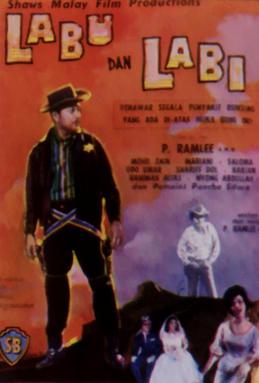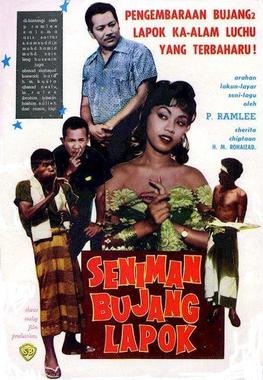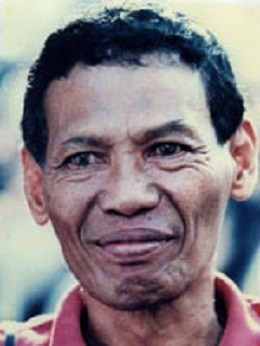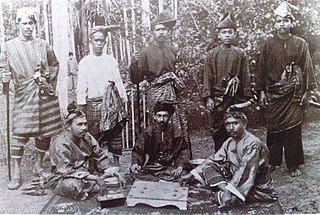This article lists important figures and events in Malaysian public affairs during the year 1980, together with births and deaths of notable Malaysians.

Tiga Abdul is a 1964 Malaysian Malay-language black-and-white comedy film directed by and starring Malaysian silver-screen icon P. Ramlee. It tells the story of three brothers who are caught in a web of trickery set by the cunning Sadiq Segaraga, who uses his three daughters to try and fleece the three brothers of all their wealth. The movie is a tribute to traditional folktales with a moral set into the story and is set in a fictional Middle Eastern country named Isketambola, loosely based on Istanbul, Turkey. It was the last film to be directed by P. Ramlee in Singapore before he moved to his new workplace in Merdeka Studios, Kuala Lumpur in 1965.

Labu dan Labi is a 1962 Singaporean Malay-language black-and-white buddy comedy film directed by and starring P. Ramlee. The movie was filmed in Singapore and it revolves around the antics of Labu and Labi, two servants with wild imaginations who work in the house of a wealthy but miserly man, Haji Bakhil bin Haji Kedekut. The movie is filmed in the style of a stage pantomime, with over-the-top comedy and featuring the characters occasionally breaking the fourth wall. The film's sequel is Nasib Si Labu Labi.

Ali Baba Bujang Lapok is a 1961 Singaporean Malay-language black-and-white comedy film directed by, written by and starring Malaysian silver-screen legend P. Ramlee and produced in Singapore by Malay Film Productions Ltd. Based loosely on the story of Ali Baba from 1001 Arabian Nights, the film is occasionally self-referential and contains elements of anarchic comedy, burlesque comedy, satire and farce. The title includes the suffix Bujang Lapok because it is the third instalment in the Bujang Lapok series of comedy films that star the trio of P. Ramlee, S. Shamsuddin and Aziz Sattar. This film marked the feature film debut of Sarimah, who would go on to a long movie career, and is also notable as one of the few P. Ramlee films where he plays the villain.

Madu Tiga is a 1964 Singaporean black-and-white Malay-language romantic comedy film directed by and starring P. Ramlee, Sarimah, Ahmad Nisfu and M. Rafiee.
Musang Berjanggut is 1959 Singaporean Malay-language black-and-white period romantic comedy film directed by and starring P. Ramlee. The story is in the style of a traditional Malay folktale, featuring supernatural elements and a story with an underlying moral. The plot follows the adventures of a prince named Tun Nila who sets out to find a woman who will marry him, and what happens when he finds her at last.

Seniman Bujang Lapok is a 1961 Singaporean Malay-language black-and-white comedy film directed by P. Ramlee. It is the fourth instalment in the Bujang Lapok series of films, but the last to feature P. Ramlee, S. Shamsuddin and Aziz Sattar as the main trio of actors. However, it is not a direct sequel to the previous "Bujang Lapok" films, as there are no references to the events of the previous films.
Pendekar Bujang Lapok is a 1959 Singaporean Malay-language black-and-white comedy film directed by P. Ramlee. It is the second in the Bujang Lapok series of films, and stars the trio of P. Ramlee, S. Shamsuddin and Aziz Sattar, all of which was filmed on site at Jalan Ampas, Singapore.
Antara Dua Darjat (English: Between Two Classes) is a 1960 Singaporean Malay-language black-and-white romantic melodrama film directed by and starring Malaysian silver-screen legend P. Ramlee and Saadiah. This film revolves around the obstacle of romance for a couple of lovers due to family holdings that adhere to the ladder of rank and descent which cannot unite those of high rank and low rank thus triggering bloody conflict, mental stress, family feuds up to hypocracy and soul murder.

Nujum Pak Belalang is a 1959 Singaporean Malay-language black-and-white comedy film directed by and starring P. Ramlee. The film is styled as a fairytale and is loosely based on a Malay folk tale.

Salmah binti Ismail, better known by her stage name Saloma, was a Singaporean-Malaysian singer, film actress, trendsetter and a fashion icon who became well known in the late 1950s.
Mariam Baharum was an early Singaporean Malay film actress who was known for her work during the 1950s and 60s. She was nicknamed Mariam Tahi Lalat by her fans.

Shamsuddin bin Dali, known professionally as S. Shamsuddin, was a Singaporean actor and comedian who appeared in Malayan films during the 1950s and 1960s.

Hang Tuah is a 1956 Singaporean Malay-language historical drama film directed by Phani Majumdar. It is the first Malay film to be fully shot in Eastman colour film. It was released in Singapore by Shaw Organisation on 28 January 1956. The film was based on the legendary Admiral Hang Tuah of Malacca and his 4 sworn brothers; Hang Jebat, Hang Kasturi, Hang Lekir and Hang Lekiu. This film received the award for 'Best Musical Score' at the 3rd Asian Film Festival in Hong Kong in 1956 and an official screening at 7th Berlin International Film Festival in 1957, where it was nominated for the Golden Bear.
Bujang Lapok Kembali Daa, or The Return of the Three Bachelors is a 1985 Malaysia Malay-language comedy film directed, written and acted in by Aziz Sattar. In this film, P. Ramlee's son, Nasir P. Ramlee (1953–2008) took over his late father's place in the trio. This would be the fifth and last installment of Bujang Lapok film series.
Anak-ku Sazali is a 1956 Singaporean Malay-language black-and-white melodrama film directed and written by Phani Majumdar. The movie is about love between a man and a woman, dreams that can come true and a father's extreme love for his son. The talented P. Ramlee plays the adult father character, Hassan as well as the spoilt son, Sazali Hassan.

The Indonesian Malaysians are Malaysian citizens of Indonesian ancestry. Today, there are many Malaysian Malays who have lineage from the Indonesian archipelago and have played an important role in the history and contributed to the development of Malaysia, they have been assimilated with other Malay communities and are grouped as part of the foreign Malays or anak dagang in terms of race. The Malaysian census does not categorize ethnic groups from the Indonesian archipelago as a separate ethnic group, but rather as Malay or Bumiputera.

Pahang Malays are a sub-group of Malay people native to the state of Pahang, in the east coast of Peninsular Malaysia. With population of approximately 1.08 million people, they constitutes 70% of Pahang state's population, making them the dominant ethnic group in the state. Their language, Pahang Malay is one of many Malayan languages spoken in the region that belong to the Malayo-Polynesian group of Austronesian family.

The National Concord was a Malaysian political coalition that was formed between the Malaysian Islamic Party (PAS) and United Malays National Organisation (UMNO) against the then-ruling Pakatan Harapan (PH) coalition which had come into power after the 2018 Malaysian general election (GE14). The political cooperation between the two largest Malay/Muslim-based parties was officialised with the signing of the Piagam Muafakat Nasional. The five-point charter was signed by PAS president Abdul Hadi Awang and UMNO president Ahmad Zahid Hamidi in the Himpunan Penyatuan Ummah held at Putra World Trade Centre (PWTC), Kuala Lumpur on 14 September 2019. Its main aim is to unite the Malay/Muslim community or Ummah for electoral purposes.











